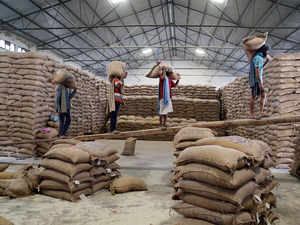
Target for wheat output has been kept at 106.5 million tonnes, same at the current level estimated for the 2019-20 crop year.

COVID-19 CASES
WorldIndiaConfirmed12,759Deaths420Confirmed2,056,055Deaths134,178NEW DELHI: The government has set the foodgrain production target at 298.3 million tonnes for the 2020-21 crop year, up 2 per cent from the record output achieved in the current year, banking on forecast of a normal monsoon.
India’s foodgrains production is estimated at a record 291.95 million tonnes in the 2019-20 crop year (July-June), beating the target of 291 million tonnes.
Addressing the National Conference on Kharif (summer-sown) crops 2020 through video-conference, Agriculture Minister Narendra Singh Tomar said all states should aim to achieve the kharif target.
He also asked them to work in a mission mode to achieve the target of doubling farmers’ income.
“IMD has forecast the June to September southwest monsoon rainfall over the country as a whole is likely to be normal. This augurs well for rain-fed kharif crops,” Agriculture Commissioner S K Malhota said.
In view of the COVID-19 lockdown, Malhotra informed state governments about the exemptions given for farm activities. He stressed on the need to follow social distancing and sanitisation during the sowing operations for kharif crops.
He said the sowing of kharif crops has already begun in some parts of the country.
Malhotra told states that the ministry has set a target of 149.92 million tonnes of foodgrains production in the kharif season and 148.4 million tonnes in the rabi (winter sown) season, taking the total foodgrain target to record 298.3 million tonnes in the 2020-21 crop year.
In the foodgrains category, rice production target has been fixed at 117.5 million tonnes in 2020-21 from estimated 117.47 million tonnes output in the current crop year.
Target for wheat output has been kept at 106.5 million tonnes, same at the current level estimated for the 2019-20 crop year.
Similarly, coarse cereals production target has been set higher at 48.7 million tonnes in 2020-21, from estimated 45.24 million tonnes output in the current crop year.
Malhotra said the target for pulses production is 25.6 million tonnes, up from 23.02 million tonnes in the current year.
In the non-foodgrain category, the ministry has set a higher goal of producing 36.64 million tonnes of oilseeds as against 34.19 million tonnes in the 2019-20 crop year.
Cotton output target has been fixed at 36 million bales compared with 34.89 million bales (of 170 kg each) this crop year.
Sugarcane production target is 390 million tonnes during 2020-21, up from 353.8 million tonnes estimated in the current crop year.
On Wednesday, the Indian Meteorological Department (IMD) forecast that the country will receive “normal” monsoon rainfall this year, raising hopes for higher farm output.
Nearly 50 per cent of India’s cultivable farm-area is dependent on the monsoon — the lifeline of the country’s rural economy and agriculture sector.
The monsoon will be 96-104 per cent of long period average (LPA), which is normal for the season.
Earlier, Tomar assured the states that the Centre will remove any obstacles that they are facing.
The main aim of the National Kharif Conference was to discuss various issues and list out steps in consultation with the states about preparedness for Kharif cultivation in view of the lockdown situation.
Tomar said that the extraordinary situation due to the coronavirus has to be met with a fighting spirit by the agriculture sector and everyone has to rise to the occasion and perform.
He said Prime Minister Narendra Modi has ensured that ‘Gaon, Garib aur Kisan’ (Village, Poor and Farmers) do not suffer during this crisis.
Tomar also asked states to explain to each farmer the PM Fasal Bima Yojana and Soil Health Card scheme.
As regards the Rabi crops being harvested currently, Tomar said it has been decided that all states will ensure procurement at village/block levels as farmers are not allowed to move out of the block due to the lockdown.
In addition, all states are taking steps for direct marketing/purchasing of crop produce from farmers, he added.
Source: indiatimes.com

